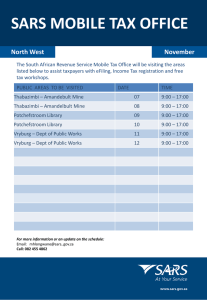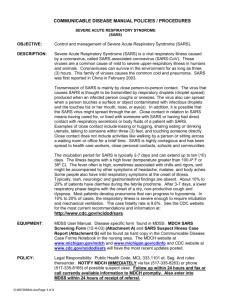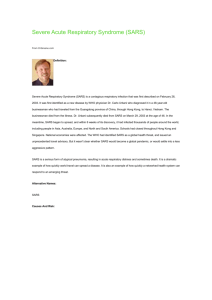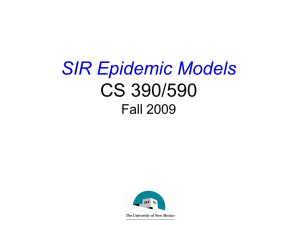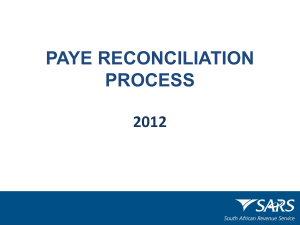Pathogen_Project
advertisement
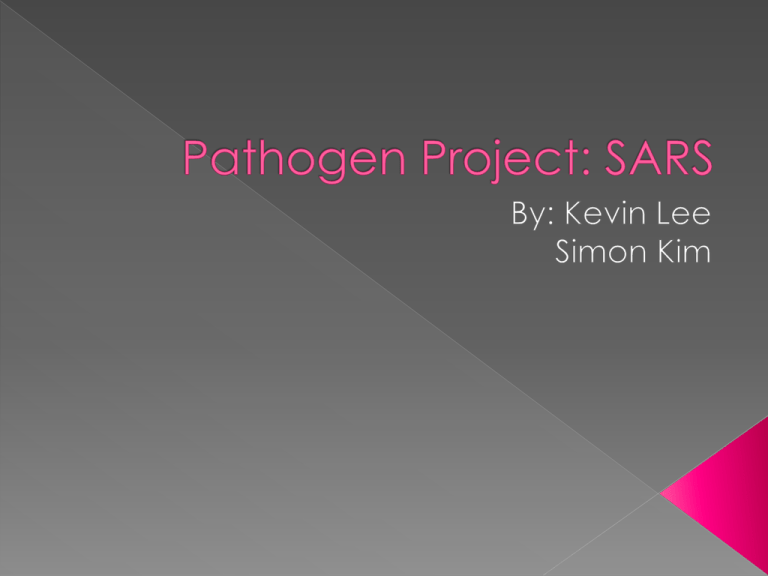
SARS, also known as Severe Acute Respiratory Syndrome, is a dangerous virus that can cause several symptoms and even death. Scientists believe that SARS was started in an animal, and that infection spread from the animal to many humans and 25 countries in just half a year. It was first described on the 26th of February in Hanoi, Vietnam in a 48 year old business man with high fever and atypical pneumonia that was getting worse extremely fast. SARS is a disease that is and was very easy to spread and obtain. Unlike other coronaviruses, SARS has low infectivity and high virulence or threat to patient organs. However, an infected person would be able to spread the contagious disease through speech because the virus is air-borne. By breathing in the virus, you would be infected as the virus would penetrate and enter the immune system. SARS is known for its rapid transmission Infectious agent, which is possibly new The potential of becoming a pandemic Global Alert on the 12th of March Is known for its rapid death toll in Asia, esp. China in which thousands of lives were taken. SARS is a part of the Coronavirus Family, which is a subdivision of the Coronaviridae Family. They are enveloped viruses that have positive single-stranded RNA genome along with helical symmetry. SARS contains Single-strand RNA that is nonsegmented and enveloped The serotype or serogroups associated with this virus are 229E and OC43 in human beings When a person is infected, the main symptom is body temperature. The normal body temperature is 98.6 F, but the average temperature for patients with SARS is usually 100.4 or higher. Another symptom is headache. The infection can start with fever, and can even lead to severe diarrhea, and pneumonia. When people get pneumonia, it causes respiratory failure, which is where most people encounter death. The initial symptoms of SARS include flu, fever, gastrointestinal symptoms, cough, and sore throat. Also, some symptoms are lethargy, which means drowsiness or being dull, unenergetic, and, overall an overpowering sleep. And Myalgia which is pain in the muscles. SARS pathogen can lead to illnesses such as pneumonia and influenza. Although the most common symptom to all patients is fever, shortness of breath also occurs later . Symptoms can appear anytime between 2-10 days after you are exposed to the disease, but even up to 13 days has been noted for symptoms after exposure. In many cases, symptoms can be seen 2-3 days after exposure 10-20%of all cases require mechanical ventilation, which is a method in medicine that assists natural breathing impulses in humans via machines. SARS goes through the lytic cycle when it replicates. Therefore, the virus exits the cell when the cell dies or bursts as the virus takes over. Because dormant diseases are relatively rare in animals, it is safe to say that SARS is not a retrovirus that goes through a lysogenic cycle. The viruses also can exit the cell through exocytosis or active transport When the SARS pathogen replicates, it is aided by the protein enzyme protease. The transcription of coronaviruses involves RNA synthesis during the extension of negative copies of mRNAs. Protease is enzyme that conducts proteolysis that begins protein catabolism by the hydrolyzing of peptide bonds. Proteolysis speeds the process of mRNA and furthermore, viral replication. Replication of the virus is done inside the nucleus of the cell This is known by the name of the disease of SARS or Severe Acute Respiratory Syndrome. Because it is a syndrome along with the many famous chromosomal disorders such as Down Syndrome or Patau Syndrome, we know it is in relevance to the chromosomes of a cell or furthermore the DNA and nucleus of that cell. Earlier, it was explained that the replication of this pathogen is catalyzed by protease, which aids in proteolysis and overall the replication of the disease. SARS is a coronavirus that gets its name from their crown-like spikes, which are made of S glycoprotein. Also, the virus is enveloped, which means it is cloaked in a membrane that is derived from a host cell. The virus binds to receptor sites on the host cell through the S glycoproteins. SARS is a virus that enters the host cell by a fusion called “membrane fusion”. This is when the SARS virus binds with the outer side of the host cell’s receptor, and enters the host cell. The virus enters the cell by injecting part of its RNA complex into the host cell to replicate inside stored in the capsid or protein coat of the virus. The worldwide death rate of SARS has increased up to, 14-15%, which is almost double the latest measurement. If older than 65 years old, more than half are likely to die, very dangerous for elders. Currently, there are 5600 SARS cases of the syndrome with 3647 of these cases in China. http://www.nejm.org/earlyrelease/SARS.jpg According to a June 10 study in 2003: There have been 8430 cases of SARS reported around the world There have been 789 deaths 5937 recovered patients 1184 currently with the disease With a 9.4% fatality percentage Out of the 8430 total cases reported: China had 5328 incidents of SARS patients, which is 63.2% of the total Hong Kong had 1754 cases which is 20.8% of the total Taiwan had 686 cases which is 8.1% of the total Canada had 229 cases which is 2.7 % of the total Singapore had 206 cases which is 2.4% of the total the USA had 69 cases which is 0.8% of the total Vietnam had 63 cases which is 0.7% of the total And the rest of the world had 95 cases which makes 1.1% of the total reported cases of SARS. The goals of the treatment are to: Block the binding to the receptor by the S protein or restrain “receptor-induced conformational change” or in other words, stop the changing of the disease through the receptor Hinder the cleave of the SARS-CoV polymerase and viral RNA synthesis noted that the polymerase gene of the CoV has to be degraded or digested by the viral protein enzymes or proteases to be active. Block the interrupted RNA transcription Block assembly of viruses in that the virus buds into pre-Golgi membranes. Inhibit the process of exocytosis or active transport of transferring waste out of the cell through phagocytosis and pinocytosis. Inhibit serine proteases to block the cleave of spike glycoproteins Through clinical trials, we know that SARS develops in stages, which includes acute constitutional symptoms, acute viral pneumonitis, acute lung injury, and acute respiratory distress syndrome. Corticosteroids are used to help lung damage from inflammatory response Also, ribavirin is an antimetabolite antrival that blocks nucleic acid synthesis and it is used for both RNA and DNA. Interestingly, recent studies have found ribavirin is ineffective. Mechanical ventilation is used to aid in spontaneous breathing Glycyrrhizin that is extracted from liquorice roots can be used to treat the virus as it inhibits its replication. Overall, treatment of SARS is done through antipyretics or fever treatment along with ventilator support. In order to diagnose this disease, two tests are performed First, the ELISA Test is used. If negative Ab on acute serum with a positive Ab test on healing serum. To diagnose SARS there must be seroconversion by the ELISA Test Also PCR test must be confirmed positive Our nature as human beings effects our chances of getting such a disease. Human demographics or population along with behavior, susceptibility to disease, economic development and land use, altering ecosystems, international travel and commerce, microbial evolution and a breakdown of health measure all will affect the emergence of SARS as a pandemic to fear. Campbell Textbook http://www.scidev.net/en/health/sars/n ews/scientists-shed-light-on-sars-virus-cellentry.html http://en.wikipedia.org/wiki/SARS http://www.cdc.gov/ncidod/sars/ http://www.who.int/csr/sars/en/ *http://www.uleth.ca/bio/bio4110/olga15. pdf
